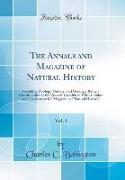- Start
- The Annals and Magazine of Natural History, Vol. 1
The Annals and Magazine of Natural History, Vol. 1
Angebote / Angebote:
Excerpt from The Annals and Magazine of Natural History, Vol. 1: Including Zoology, Botany, and Geology, Being a Continuation of the 'Annals' Combined With London and Charlesworth's 'Magazine of Natural History, 'These prolongations take rise from the sides only of the rings of the body - that is, from the pleurae or lateral folds be tween the dorsal and ventral plates, and in that case the pleurae may be covered to a greater or less extent by a de posit Of chitine forming a lateral plate, called the epimeron, which affords support for the muscles which move the basal joint of the limb, the hi or coxa.It is also from the p eurae alone that the peculiar prolonga tions arise which are in the service of respiration, either out side the body as gills or branchiae, or inside as tracheae. From the dorsal and ventral arches of the rings, on the con trary, no limbs ever take rise, although they Often carry other more superficial formations (which may also be subservient to locomotion) for the purpose Of supporting or fixing the body, such as groups of sharp granules, indentations, spines, retrae tile warts, Often with hooks disposed in circles, &c., To this last class belong the so-called ventral or false feet of many larvae. The cerci of Insects with perfect metamorphosis (both of imagos and of larvae) are merely transformed dorsal spines.The head consists, as all the other rings of the body, of a dorsal arch, a ventral arch, and two side pieces. In this case, too, it is merely from the side pieces that the limbs take rise, namely the appendages of the mouth, and, besides, the eyes and antennae. But as the head, besides one or two pairs of an tannae, possesses three pairs of limbs (appendages of the mouth), whilst none Of the other rings have more than one pair, the lateral pieces or pleurae of the head (cheeks and temples) pre onderate so greatly over the dorsal and ventral pieces, that t ey occupy the greater part of the skull, particu arly behind and above, where so much space is required for the accommodation Of the muscular and nervous systems, whilst the dorsal and ventral pieces lose so much the more in extent as they are here relieved from the Office they perform in all the other rings (saving the last of all), viz. To afford sur face Of insertion for the muscles which move the next fol lowing ring. The dorsal piece is therefore reduced to a plate above the mouth (the epistoma), from which separate pieces, viz. Clypeus, labrum, labellum, are evolved in proportion as the mouth requires covering from above. The ventral piece, on the contrary (hypostoma, or the sphenoid plate, as it may be called from its analogy to the os sphenoideum of vertebrata), enters into closer relations with the a pendages of the mouth, as will be shown more in detail by-an -by, from this, too, sepa rate pieces are evolved in front, namely mentum and fulcrum labii, in proportion as the maxillae and lingua with their muscles require support and cover from beneath.About the PublisherForgotten Books publishes hundreds of thousands of rare and classic books. Find more at www.forgottenbooks.comThis book is a reproduction of an important historical work. Forgotten Books uses state-of-the-art technology to digitally reconstruct the work, preserving the original format whilst repairing imperfections present in the aged copy. In rare cases, an imperfection in the original, such as a blemish or missing page, may be replicated in our edition. We do, however, repair the vast majority of imperfections successfully, any imperfections that remain are intentionally left to preserve the state of such historical works.
Folgt in ca. 10 Arbeitstagen

